Introduction: Asymptomatic arrythmias can result in adverse events including sudden cardiac death. Bradycardia is prevalent in active populations and can remain asymptomatic or become malignant. Pauses of six seconds in duration and syncope are the present criterion recommended for treatment. To the best of our knowledge, this is the first report supporting the use of intermittent ECG monitoring to identify an asymptomatic arrythmia associated with bradycardia which resulted in eventual placement of a pacemaker. Case presentation: The subject matter is a 31-year-old male recreational athlete who took chest and thumb ECGs intermittently throughout a 2-day period. On both days, abnormal rhythms were identified more than once in one of the leads. Follow up diagnostics included a 24-hour Holter revealing 6 isolated action potential durations, 2 isolated pre-ventricular contractions, 6 supraventricular ectopic beats, 2 ventricular ectopic beats, 28 bradycardic events and 18 pauses. At 6 month follow up, an insertable loop recorder identified 117 events with 112 pauses and 5 bradycardic events. Eleven of the pauses were of >6 seconds duration. A near syncope episode including symptoms of tunnel vision, nausea, diaphoresis and almost loss of consciousness resulted in hospitalization. The ECG at time of hospitalization showed normal sinus rhythm with ST-segment elevation and tall T waves. A dual chamber pacemaker was placed to prevent future episodes of syncope. Conclusion: The present case study highlights the need for additional objective criteria to identify patients requiring early management of asymptomatic bradycardia to prevent unnecessary hospitalization. Intermittent ECG assessment may provide an additional complimentary assessment which can regularly be utilized to monitor patients with asymptomatic arrythmia. De-conditioning may not be an option for treatment and waiting for syncope to occur leaves patients susceptible to sudden cardiac death or mortality as a result of uncontrollable circumstances at time of a near syncope episode. Development of additional monitoring processes and criteria for early pacemaker implantation are warranted.
intermittent ECG, bradycardia, Mobitz type 1 Second Degree AV block, syncope, pacemaker
ECG: Electrocardiogram; SM: Subject Matter; ILR: Insertable Loop Recorder; STE: ST-Segment Elevation; EP: Electrophysiologist
Individuals with high levels of fitness or who lack cardiac awareness may be unmindful of heart rhythm abnormalities. Asymptomatic arrythmias are considered benign until patients experience symptoms such as dyspnea, syncope, chest discomfort or fatigue [1]. Asymptomatic bradycardia is prevalent in athletes and active populations such as military personnel [2]. The ability to discriminate when symptoms may become relevant and require medical intervention remains to be well defined [1]. Bradycardia often persists following cessation of training and only a small percentage of retired athletes are reported to require pacemaker implantation [3].
The American Medical Association and American Heart Association does not recommend ECG assessment for evaluating development of heart disease in active populations. Similar to sedentary individuals preventative monitoring is non-existent unless a medical event occurs. Recent developments in portable ECG technology currently allow for the regular monitoring of heart rhythms via an individual’s smart phone. The present case study demonstrates the utility of monitoring for on-going heart disease in active populations and suggests a potential use for portable ECG technology in the preventative medical process.
The patient was a 31-year-old male recreational athlete (SM) participating in running, weightlifting and basketball. The SM was 76.6 Kgs and 175 cm tall. His medical history included mTBI from a high school football injury. The SM was asymptomatic for any signs of on-going heart disease and had not experienced any form of syncope; however, the SM would become lightheaded after vomiting. The SM was consulting for the heart diagnostics company and given his interest in heart health, the SM had begun measuring his heart rhythm using the portable 2-lead ECG (thumb and chest leads; Coala Life, Inc, Irvine CA). The SM took assessments throughout the day and on multiple occasions the device reported in one of the leads abnormal beats classified as unexplained abnormalities which may or may not be atrial fibrillation (afib) or paroxysmal afib or abnormal fast/slow sequences (Figures 1-3). At all times the SM was asymptomatic.
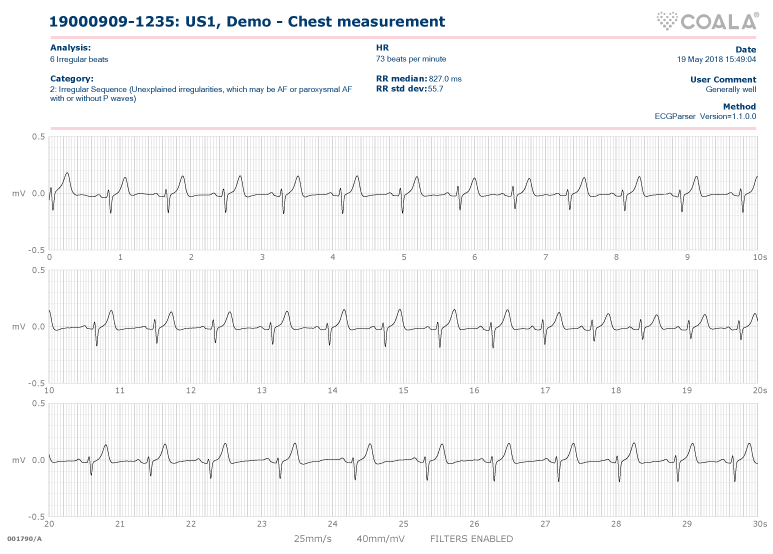
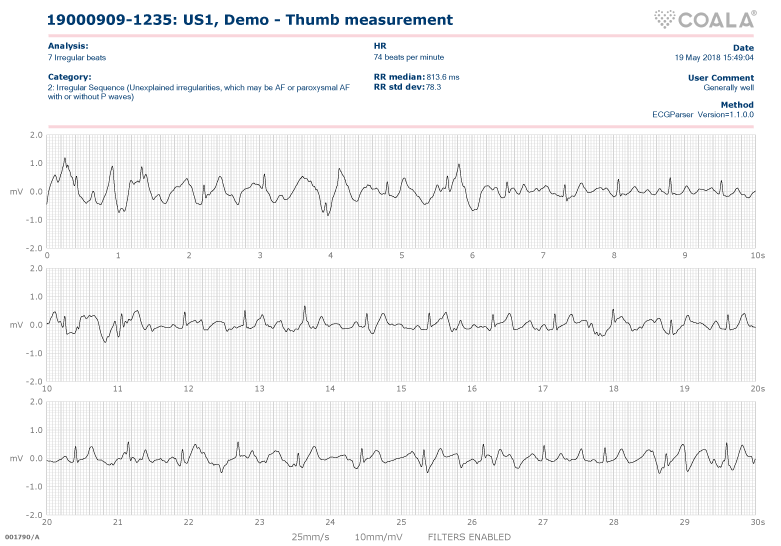
Figure 1: Irregular Sequence (A) Chest measurement (B) Thumb measurement
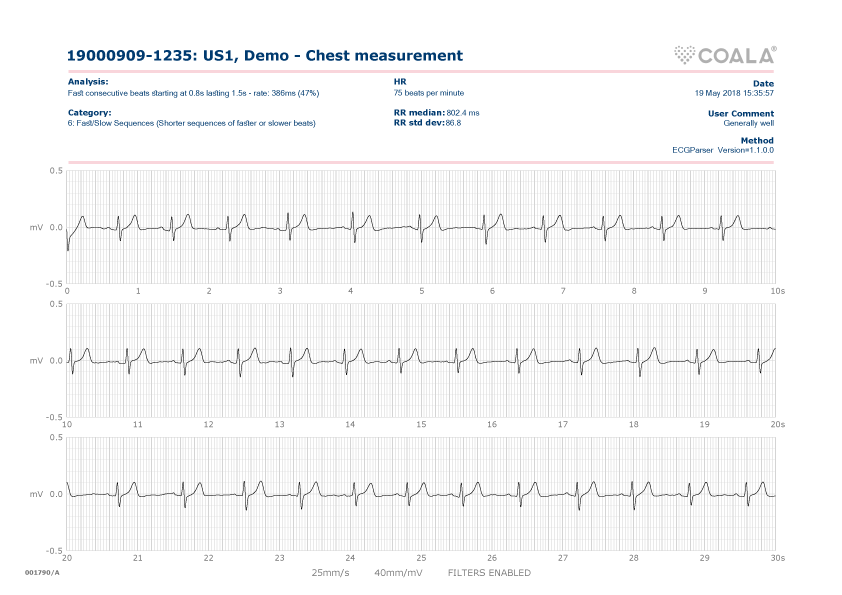
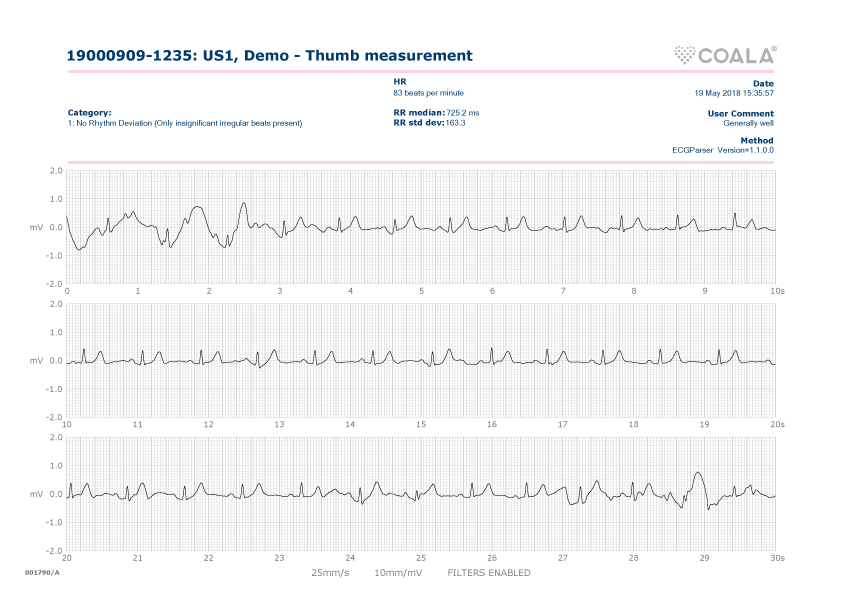
Figure 2: Irregular fast slow beats (A) Chest measurement (B) Thumb measurement
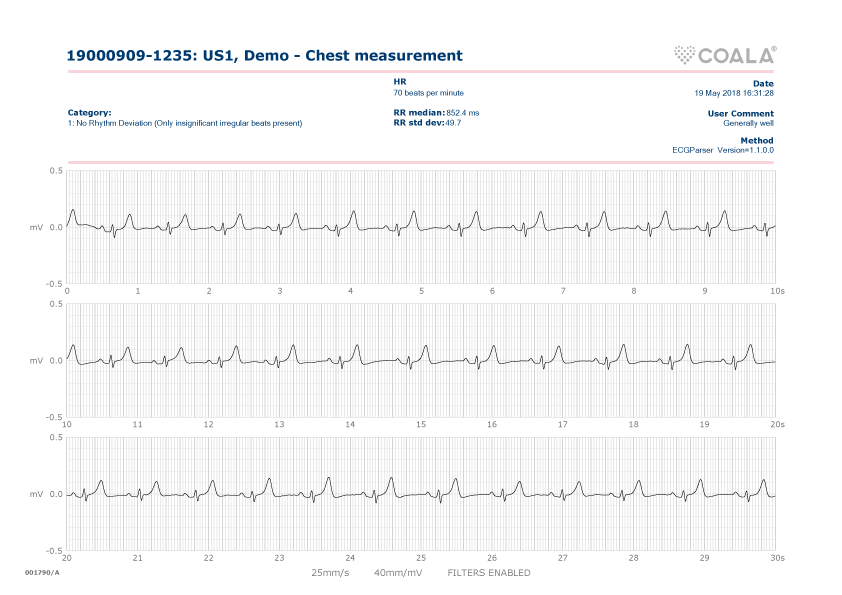
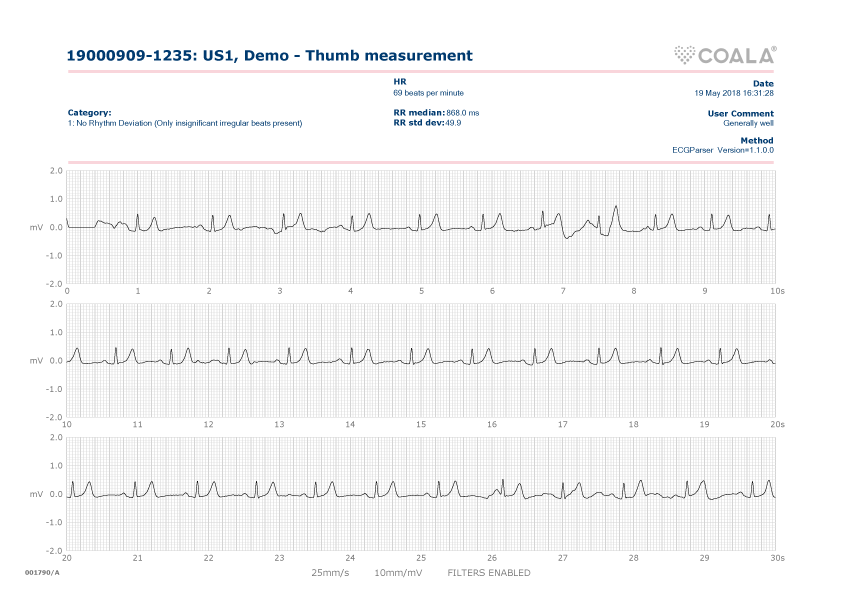
Figure 3: Regular rhythm (A) Chest measurement (B) Thumb measurement
In a follow up consultation with a cardiologist, a 24-hour Holter monitor was utilized to further evaluate for arrythmias. Results of the 24-hour Holter assessment identified the following: 6 isolated action potential durations, 2 isolated pre-ventricular contractions, 6 supraventricular ectopic beats, 2 ventricular ectopic beats, 28 bradycardic events and 18 pauses. While asleep, one of the pauses was identified as lasting 7.5 seconds. All of the pauses were attributed to Mobitz 1 second-degree AV block. There were p-waves without a QRS complex and four consecutive p waves that did not conduct. Given the episodes of bradycardia and pauses, an assessment for obstructive sleep apnea was performed and found to be negative.
On a six month follow up, the SM reported increased symptomology including chest tightness in which he described the heart feeling attached to the rib cage. He had also begun wearing a smart watch to track heart rate which could regularly be found in the mid 40’s throughout the day and below 40 while sleeping. As a result, an insertable loop recorder (ILR; Medtronic Carelink; Dublin, Ireland) was placed for further assessment. Over the next 3 months, 117 events which included 112 pauses and 5 bradycardic events were recorded. Eleven of the pauses where greater than 6 seconds in duration.
During this time, the SM experienced a pre-syncopal episode in which he felt light headed, stopped his activity and laid down. Symptoms included tunneled vision, nausea and diaphoresis and an inability to respond to those around him. Bystanders reported him as being very pale and emergency medical services repeatedly told the SM he may need to be shocked due to his low heart rate and inability to respond. The SM was not treated with atropine and the ILR did not record an event at the time of the incident.
Upon examination by emergency room medical staff, the SM continued with nausea and was provided 1-liter fluid for resuscitation. An ECG showed normal sinus rhythm with ST - segment elevation (STE) and tall T waves. Symptoms improved but fatigue and light headedness continued. The SM had experienced a mild TBI one week prior to the event. When asked if he would have been able to maintain control of a vehicle, the SM responded: “no”. Vitals over the next 24-hour period included systolic/diastolic blood pressure of (124-138) (76-101), heart rate 63-83 bpm, respiration rate of 16-20 per minute and SpO2 of 95%-100%. Blood chemistry reported an overall normal thyroid stimulating hormone (3.18 MCU/ML), complete blood count and comprehensive metabolic panel with only sodium (136 mmol/L; reference range: 137-147 mmol/L) and potassium (3.4 mmol/L; reference range: 3.5-5.1 mmol/L) slightly out of range.
The SM opted for dual chamber pacemaker (Biotronik; Berlin, Germany) placement when offered by the attending electrophysiologist (EP). An echocardiogram did not reveal any abnormalities in structure or function of the heart. The EP concluded the SM to have unusual dysautonomia which was responsible for intermittent bradycardia and AV block. Due to additional frequent near syncope episodes after pacemaker placement, the SM worked closely with the EP’s staff to adjust the settings (lower: 65bpm, higher: 165bpm) and prevent future occurrence of these episodes.
The present case study demonstrates the utility of an intermittent ECG monitoring device for early detection of an eventually symptomatic arrythmia and the value of performing frequent assessments throughout the day. Prior research examining the use of intermittent ECG reported the need for 19 minutes of recordings to identify rhythm abnormalities warranting further investigation [4]. In the present case study, the SM recorded 24 minutes of intermittent ECG over a two-day period which further supports the time component previously identified and provides further protocol for use of intermittent monitoring in the clinical setting.
Bradycardia and Mobitz type 1 AV block are assumed to be benign in asymptomatic patients; however, bradycardia is associated with prolonged QT intervals which may result in syncope or sudden cardiac death. The SM in the present study had several indications identified throughout the assessment process which prompted the implantation of a pacemaker including pauses of 6 seconds or more during sleep, an ECG with STE early repolarization and pronounced bradycardia. While theoretical, long pauses (>4s) during sleep have been proposed to account for sudden death reported in patients with bradycardia [5]. Malignant early repolarization in active populations has a prevalence of 8-44% and in survivors of sudden cardiac arrest has remained persistent regardless of detraining or retirement [6]. A recent meta-analysis highlighted that the previously determined cut point of 3 second pauses cannot discriminate between athletes who will become symptomatic and early repolarization with STE and J points can be malignant or benign [6,7]. As such, development of additional objective criterion and monitoring processes are warranted to ensure athletes are not susceptible to severe consequences, such as sudden death or mortality as a result of uncontrollable symptoms (eg. inability to maintain control of a vehicle).
Current guidelines recommend de-conditioning athletes with symptomatic bradycardia and possible implantation of a pacemaker when symptoms do not resolve [1,6]. Prior reports suggest approximately 3% of retired athletes require a pacemaker to continue a healthy lifestyle of reasonable physical activity [3]. The SM in the present study did not report a training load substantial enough to warrant reductions in training. As such, a pacemaker was utilized to alleviate re-current near syncope and ensure the safety of the patient.
Portable ECG devices provide the ability to repeatedly monitor for arrythmia. In the present case report, the patient’s ability to make assessments when desired made a clinical difference allowing for early identification of an asymptomatic arrythmia. Asymptomatic bradycardia warrants regular on-going assessment in order to prevent adverse events and ensure the health of active populations. Identification of more objective criteria for early pacemaker treatment and robust monitoring protocols to prevent sudden cardiac death, adverse events and mortality in this population is warranted.
KA wrote the paper, checked the medical records and the literature and wrote the manuscript. RC assisted with the writing of the manuscript. BR was the patient and collected the data, provided the medical records and reviewed the manuscript for accuracy.
KA is a consultant for Coala Life, Inc. BR was previously a consultant for Coala Life, Inc.
The present article is a case study and the SM provided permission for use of the presented data. The SM also serves as a co-author of the paper.
Given the medical nature of the data presented, the data is retained by the SM and was shared with the co-authors for the sole purpose of the case report. Any specific data requests will need to be made to the corresponding author.
KGA was funded by Coala Life, Inc.
- Arnar DO, Mairesse GH, Boriani G, Calkins H, Chin A, et al. (2019) Management of asymptomatic arrhythmias: a European Heart Rhythm Association (EHRA) consensus document, endorsed by the Heart Failure Association (HFA), Heart Rhythm Society (HRS), Asia Pacific Heart Rhythm Society (APHRS), Cardiac Arrhythmia Society of Southern Africa (CASSA), and Latin America Heart Rhythm Society (LAHRS). Europace euz046. [Crossref]
- Vinsonneau U, Pangnarind-Heinz V, Paleiron N, Heinz LM, Rohel G, et al. (2015) Evolution of Early Repolarization Patterns after 5 Years in a Military Population at Low Cardiovascular Risk and Practical Implications in Military Medical Expertise. Ann Noninvasive Electrocardiol 20: 420-425. [Crossref]
- Baldesberger S, Bauersfeld U, Candinas R, Seifert B, Zuber M, et al. (2008) Sinus node disease and arrhythmias in the long-term follow-up of former professional cyclists. Eur Heart J 29: 71-78. [Crossref]
- Ramkumar S, Nerlekar N, D'Souza D, Pol DJ, Kalman JM, et al. (2018) Atrial fibrillation detection using single lead portable electrocardiographic monitoring: a systematic review and meta-analysis. BMJ Open 8: e024178. [Crossref]
- Heidbuchel H (2018) The athlete's heart is a proarrhythmic heart, and what that means for clinical decision making. Europace 20: 1401-1411. [Crossref]
- Senturk T, Xu H, Puppala K, Krishnan B, Sakaguchi S, et al. (2016) Cardiac pauses in competitive athletes: a systematic review examining the basis of current practice recommendations. Europace 18: 1873-1879. [Crossref]
- Aagaard P, Baranowski B, Aziz P, Phelan D (2016) Early Repolarization in Athletes: A Review. Circ Arrhythm Electrophysiol 9: e003577. [Crossref]






